I came across a realization a few weeks ago. When doing a product review, it helps to supplement the writing with video. The problem was, I didn’t have a good way to capture high-quality video with any of the older devices I have. I had tried with a built-in iSight as well as an external one, an older Sony camcorder recording directly to DV video in iMovie and a few webcams and digital cameras as well. But none of those were producing quality videos, especially not in High Definition. So I embarked on a bit of a challenge, to get my hands on a couple of the leading portable HD video cameras out there: the Flip UltraHD and the Kodak Zi8.
I don’t have the luxury of having a gadget expense account. All that I have to rely on is the kindness of vendors and PR firms to supply me with either loans or donations of the latest and greatest technology gear. For the most part, because of my technology passion, coupled with the fact that I have about 3 years of doing gadget reviews under my belt, I guess that I have a bit of a gadget reputation. Regardless, I turned to Twitter to help with this review, specifically getting these two HD cameras. I love the power of Twitter. While it took a few weeks, the end result was that I can now use either the Zi8 or the UltraHD in my future product reviews (as well as filming some family movies on the side). A special thanks goes out to both the Flip and Kodak folks (and their PR firms) for graciously donating these devices to me for use in my future product reviews and event coverage.
The Flip UltraHD

The Flip UltraHD comes with the camcorder, a rechargeable battery pack, wrist strap, soft case and a quickstart guide. Also, there is no need to buy a SD media card to store your videos as it comes with storage (8 GBs). Within the storage is also the FlipShare software that lets you easily manage your videos, create movies, take snapshots from videos and share your videos with various communities.
Setting up the UltraHD is very easy (and you can tweak any of the settings later by holding down the bright red button when the Flip is starting up).
When powered, the 2†display screen is bright and easy to see. There is also an indicator of the amount of time remaining in storage. Storage itself is 8 GB which can hold about 120 minutes of 16:9 720P HD video. Once a movie is recorded, it can be played back on the view screen. You use the right and left arrows to navigate through each of the recorded scenes. You also have the ability to do playback on an HDMI compatible device. Note that there is not an HDMI cable provided and that the cable is an HDMI mini cable, not standard.

The FlipShare software contains the very basic functionality for downloading, managing and sharing your recorded HD media. The features and look and feel are consistent cross-platform and since the software remains with the Flip, you can install it on any computer that you need to. This is a very handy feature. Very rudimentary movies can be created using the FlipShare software. Below is a series of screens that show the 4 steps to create a movies with a title, multiple HD movies, credits and music. The process only takes a few minutes (depending on the length of the videos).
You also have the ability to share your content via email, greeting cards or online, as well as through a service called the “Flip Channelâ€. This is essentially a community of Flip video users where people can create and share the movies they created on the Flip.
Your movies are easily organized within folders grouped by dates within the FlipShare software. While the software features are very basic, they do their job quite well.
I like the fact that the Flip UltraHD can stand up on its own when placed on a level, flat surface and doesn’t need a tripod for hands-free operation. It is not always ideal to lug around a tripod or Gorillapod (a very cool tripod that has flexible legs/arms that can be wrapped around just about anything stationary or on uneven surfaces). The UltraHD works best when filming in bright light and of items in a distance. I don’t recommend using it for low-light or product close-ups. It’s great for family get-togethers or snapping quick HD videos of events. Think of it as a simple point-and-click camera versus a digital SLR (where the digital SLR would be a higher end HD camcorder like the Sony HDR-XR500).
Overall, the Flip UltraHD seems to be a reliable portable HD camcorder. It’s a good entry-level camera that can do a majority of what an average family might want in a portable camcorder. It feels solid enough to give to a kid to use, yet produces quite good HD recording.
The Kodak Zi8

As the Apple iPod Nano was announced, I tweeted out “The new Nano doesn’t do HD so I’m sticking with Flip UltraHD (and possibly Kodak Zi8)“. Within a few minutes, Robert Scoble (avid, blogger, vlogger, who I have met a few times and who I knew was a Flip Video user in the past), tweeted out “The new Nano doesn’t do HD @HighTechDad says. I agree, big winner is Kodak here. The new Zi8 totally rocks.“. That response plus a few other tweets I had seen started to convince me that that the Kodak was going to be a big contender for the leadership spot.
I was very excited when I received the Zi8. It is slightly larger in length and width than the Flip UltraHD but its thickness is a bit less (0.9 inches vs. the Flip’s 1.17 inches). It also has less of a boxy look than the Flip and the surface is much more glossy and polished (the UltraHD is more of a matted color and material). When you have glossy surfaces, fingerprints tend to stand out, which they do on the Zi8. Not a huge deal since a soft cloth wipes it clean.
The Kodak Zi8 comes with the camcorder, Kodak Li-ion rechargeable battery, HDMI & A/V cables, user guide and wrist strap.
One thing that the Zi8 does NOT come with is a SD or SDHC card. I found this to be really annoying as the 128 MB internal storage is good for about 3 seconds of HD video, hardly long enough to test. So I had to order an SDHC card from Amazon. Luckily, these types of cards abound. You probably should look for a Class IV (search) or Class VI (search) as they will perform a bit better supposedly. I picked up a Transcend 16 GB SDHC Class 6 card for about $38 from Amazon. It is convenient to be able to immediately record with the Flip right out of the box I must say. But in retrospect, having the ability to quickly and easily swap out SD/SDHC cards makes the Zi8 a bit more appealing.
The screen on the Zi8 is about 2.5″ diagonal, is clear, crisp and bright. Sound quality from the speakers is tinny (like the Flip) but you do get full audio and video playback on both devices.
Like the Flip, the Zi8 has a series of buttons on the 
Like the Flip, the Kodak has a pop-out USB connector. However, instead of being a rigid arm, the Zi8’s has one that is flexible and has a bit of a give to it. This is particularly handy if you are using a laptop that sits flat on a desk (although mine are raised using various USB cooling fans). The Flip’s is solid and I was a bit worried about bending or breaking it as I connected it to a free port. Both the Flip and the Kodak seemed to function fine on both the high-powered and low powered USB ports on my MacBook Pro. Also, both the Flip and the Kodak use the USB connection to charge the internal batteries. The Kodak, though, does include a handy USB wall charger which is great if you don’t have your laptop or computer with you. 
A few other nice features that are built into the Zi8 is their “smart face tracking” technology which is supposed to ensure good lighting when it recognizes faces. Also, the Zi8 supposedly has better low-light capabilities which is useful when filming in a dark room or at dusk. Lastly, the Zi8 also functions as a 5.3 MP still camera (on the Flip, you have to use the included software to take snapshots from videos). This is very handy to have and eliminates the need to have to carry around another point-and-click camera. Note though that there is no flash built in so it is only good for well-lit shots. There is a 4x digital zoom (compared to the 2x digital zoom on the Flip) which works fairly well but in lower light situations, it can get a bit grainy and pixilated. Lastly, there is the option to connect an external microphone (stereo) which is a nice add-on, especially for face-to-face interviews and such. (I have not tested this yet.)
Kodak chose to use ArcSoft’s MediaImpressions for their PC video management software. For the Mac user, they simply relied on iPhoto for managing the video and photos (which was fine by me). Below are some screenshots of MediaImpressions in action. You are initially greeted with some basic sharing and management functions:
Once you download your videos from the Zi8, you can manage them (and other media) through the interface. You can tag videos and categorize them fairly easily. The ArcSoft software is contained within the Zi8 so you can install easily on any computer.
Creating a quick movie is just as easy as on the Flip. There are a few more functions (like themes) and the places you can easily share to (like YouTube, Facebook, Vimeo and others) as well as the ability to quickly archive to DVD.
Lastly, MediaImpressions has the ability to convert and export your videos to other devices like Sony PSPs or Apple iPods/iPhones.
Overall, I found the Kodak Zi8 to be excellent in terms of its features and capabilities. My only complaints were that you can’t stand it on a table (like you can with the Flip) and that it doesn’t come with a SD card (even a 4 or 8 GB SD card would have been nice). The picture quality and audio are both quite good. It seems to me that the Kodak team took the Flip and tried to improve on some of the features therein. I view the Zi8 as more of a “business” device, with a bit more configurability (e.g., you can choose the different HD formats on the fly: 1080p/30 frames per second, 720p/60fps, 720p/30fps, WVGA/30fps and still shots/camera mode). While it is hard to notice the difference quickly, more careful viewing of the output reveals crisper details and better panning, especially when using the 60fps option.
Head to Head
I have a feeling that this market of portable HD video cameras will start to get cluttered over the next year or so. Flip was probably the first big entrant into the space, at least the one that did so with the most splash and recognition. Since then, other competitors have arrived with good fanfare including the Kodak Zi6, the Samsung HMX-U10, the Kodak Zi8 and most recently, Apple’s iPod Nano (although the Nano doesn’t really fall into the category that well since it doesn’t record HD video). I would have liked to include the Samsung in this comparative review but unfortunately I don’t have access to one.
One of the best ways to compare these two devices is to simply look at the specs side-by-side:
| Flip UltraHD | Kodak Zi8 | |
| Sensor Type | 1/4.5″ HD 2.2 MP CMOS | 1/4.5-type 1.6 MP CMOS |
| Lens | f/2.4 | 6.3mm, f2.8 fixed focus 35 mm equivalent: 61 mm (1080p), 46 mm (720p/60fps, 720p, WVGA), 42 mm (still) |
| Zoom | 2x digital | 4x digital |
| Display size | 2 inches | 2.5 inches |
| Storage | 8GB | 128 MB internal, SD/SDHC expansion card slot |
| Focus Modes | Fixed Focus | normal/macro |
| Focus Range | 1.5m to infinity | normal: 100cm – infinity/macro: 15cm |
| White Balance | auto | auto |
| File Formats | H.264, AAC MP4 | video: H.264(MOV), AAC LC; still: JPEG |
| Capture Mode(s) | 720p (1280×720,30 fps) | 1080p (1920 × 1080, 30 fps) 720p/60 fps (1280 × 720, 60 fps) 720p (1280 × 720, 30 fps) WVGA (848 × 480, 30 fps) Still (5.3 MP, 16:9 widescreen, interpolated) |
| Microphone | wide-range stereo microphone | yes (monaural) |
| Speaker | yes | yes |
| I/O interfaces | USB 2.0 (high speed) HDMI |
USB 2.0 (high speed) AV out HDMI DC in external mic jack (stereo) |
| Battery | Flip Video AA rechargeable battery pack (1.2 volt NiHM) | KODAK Li-ion Rechargeable Digital Camera Battery/AC adapter |
| Dimensions (l x w x h) | 4.25 x 2.19 x 1.17 inches | 4.5 x 2.4 x 0.9 inches |
| Weight | 6.0 oz | 3.9 oz (w/o batteries) |
| MSRP | $199.99 | $179.95 |
| Current Amazon Price (on 9.30.09) | $161.98 – Amazon link | $179.95 – Amazon link |
I recommend taking a look at this quick video review. You can see up close shots of both the Flip UltraHD and the Kodak Zi8 in action as well as a quick video side-by-side of the same scene filmed simultaneously. (Note: these close up videos were filmed using the Sony HDR-XR500)
Summing up the Good & the Bad
Both the Flip UltraHD and the Kodak Zi8 fill the need for portable HD video recorders. They both have small form factors and produce great quality video images. They are extremely easy to use and each have their own software for managing movies, creating content and sharing with a variety of sources. At around the same price point, each device is worthy of being on a shortlist of gadgets to get for your family. The Amazon price for the Flip UltraHD makes it currently slightly more reasonable than the Zi8, but if you weigh in the items I mentioned above as well as the bullets below, you might want to consider the Kodak Zi8 as the leading candidate. Quickly:
- Tripod-less: The Flip stands up on its own, Kodak needs a tripod. Both have tripod connectors. Winner: Flip
- Focus: Both have auto focus. However the Zi8 has a Macro focus for close-ups. Winner: Kodak
- Microphone: Both have built in mics. Zi8 has a jack for an external stereo mic. Winner: Kodak
- Price: MSRP has the Zi8 slightly less, however discounts for Flip exist and newness of Kodak come into play. Look at features!. Winner: TIE
- Lens: While it is nice that the UltraHD has glass covering the lens, it is very easy to smudge it with fingerprints. Zi8 has recessed lens. Winner: Kodak
- USB connector: Both devices have pop-out USB connectors. Flip’s is rigid and Zi8 is flexible. Winner: Kodak
- HDMI: Both have HDMI out – with the Flip, you must purchase an extra cable; with Kodak it is included. Winner: Kodak
- Zoom: There is a 2x digital zoom on the Flip and a 4x digital zoom on the Kodak. Winner: Kodak
- Video formats: The Flip has 1 HD format only. The Kodak has 3 plus 1 non HD and stills. Winner: Kodak
- Camera: With the Flip, you need to use the software to “take pictures” from a video. The Kodak actually has a “camera mode” built in on. Winner: Kodak
- Image Stabilization: Don’t drink coffee with the Flip. Stabilization is built in on the Zi8. Winner: Kodak
- Storage: The Zi8 uses a removable SD card which is not include but is useful if you want to carry multiple cards. The Flip’s is internal so you are good to go from the start. Winner: Your choice
- Picture Quality: It’s a bit too soon for me to really judge this. In some quick initial tests, the Zi8 seemed to have better color balance. Winner: Still evaluating
- Power Up Time: Both seemed to have the same power-up times of about 2 seconds or less (which is GREAT!). Winner: TIE
- Community: While sharing is built into both, the Flip Channel community seems much stronger. Winner: Flip
In my evaluation of the two devices, the Kodak Zi8 seems to have a pretty strong edge over the Flip UltraHD. In my opinion, the Zi8 is more oriented towards the “business professional†or geeky parent who knows the different HD formats, and UltraHD more family oriented to the general family who doesn’t care too much about the techy stuff and just wants something that is easy to use and the management software is the same across both Macs and Windows. If you want more features and configurability for the price, I would get the Kodak Zi8. If you are at your local Costco, Target or Walmart and see the Flip UltraHD for a good price, get it for the family.
HTD says: Consumer High-Definition video capture devices are really becoming reasonable. It’s best to do some side-by-side comparisons though, before you take the plunge.
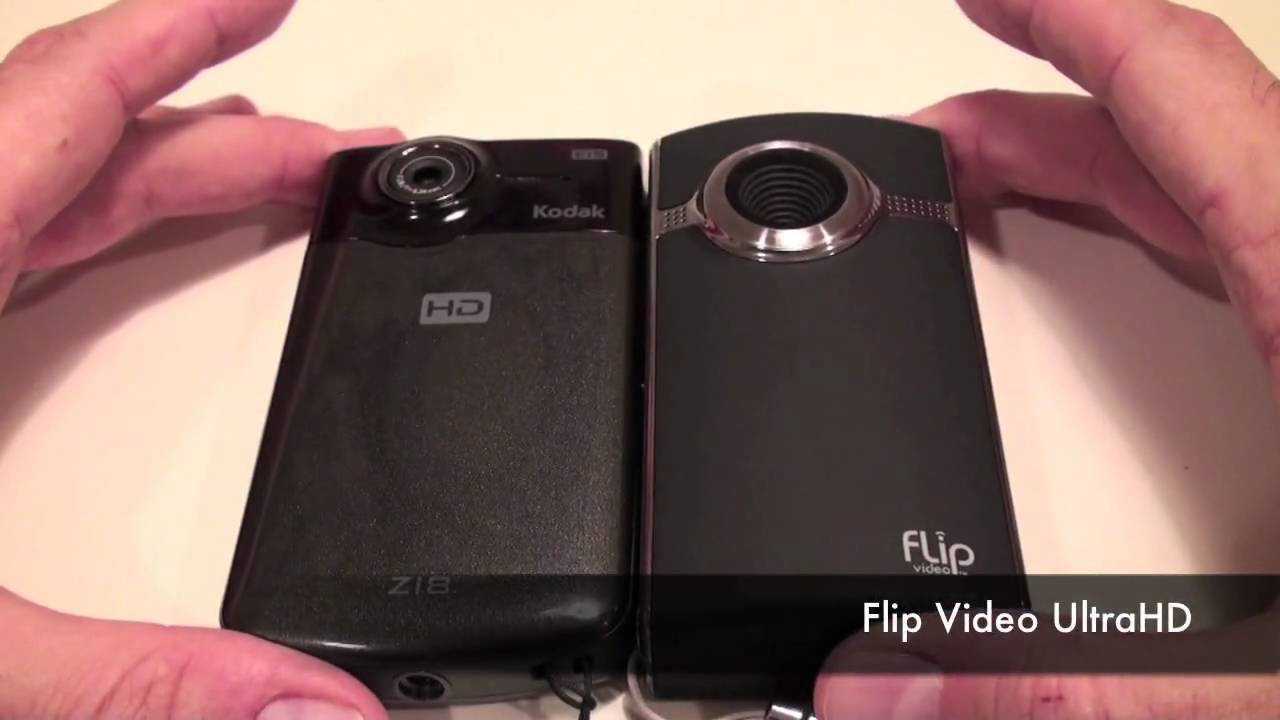
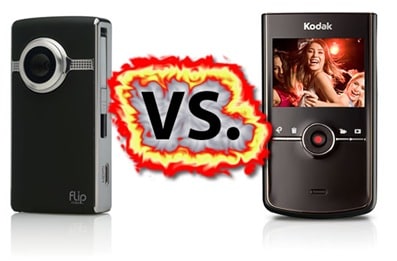

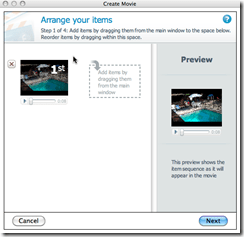
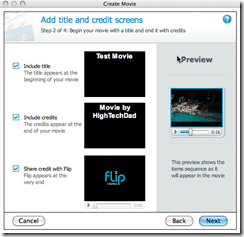
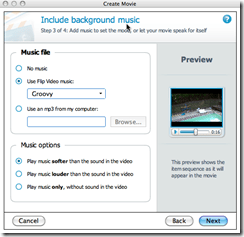
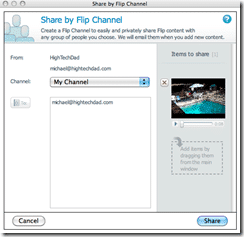
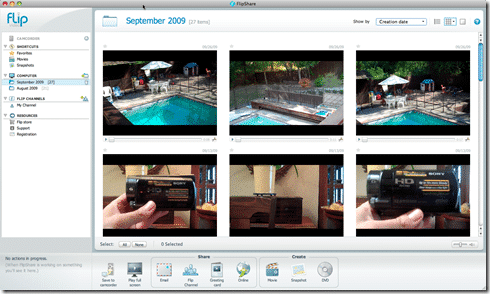
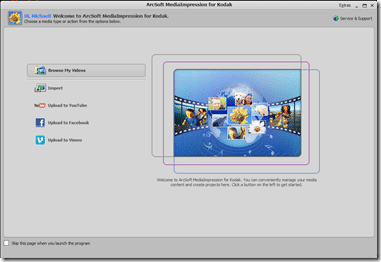
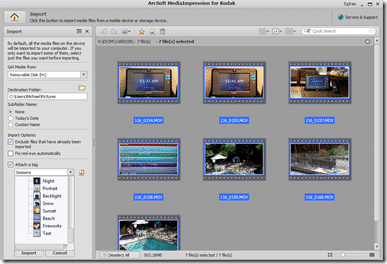

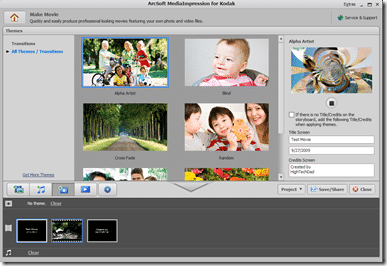
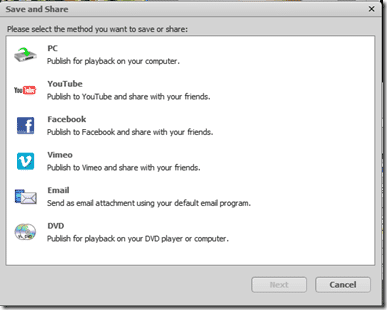
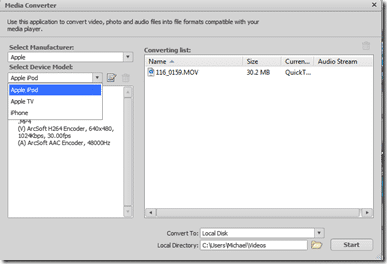


94 comments
David
I,ve had both of these and there is simply a clear winner – the KODAK ZI8, its functionalbility leaves the flip blown out of the water, Only when you have tried both can you comment on this, Kodak is an easy winner
Chris
Great review. I want to buy a camera for shoot exercise, cooking and interview videos, don’t have to be a big professional one but something that will look and sound great, what would you recommend? Kodak Zx5, Zx3, Zx6, Zi8 or others
hightechdad
I haven’t had hands on with the new kodaks yet. Just look at the features the have and choose the best and the newest!
Anjsmiles
I recently purchased a refurbished Kodak zi8 video cameravia Amazon.com. The camera
arrived yesterday and upon trying it out I have noticed that there is a
small visible dot at the top middle of the screen on both the LDC
pre-view screen and in the downloaded videos. I tried cleaning the unit
to make sure there wasn’t any dust on the lens and this does not seem
to be the issue. I am assuming that this model is defective some how. Do you know of anything that could be causing this issue?
My other frustration is that I downloaded the MediaImpression softward from the camera but can not get it to run. It keeps saying there is an error. I have searched the net and can not find any information about what to do. Since I can’t edit the videos in Windos Movie Maker I really need to be able to use this. Any comments?
I like the zi8 otherwise.
Nikki
Can’t see the post for some reason. All I can see are the comments.:|
Jack
Interesting.. I chose to buy the flip after trying out the kodak and thinking it was a bit too flimsy. I really like the flip though, has served me very well :-)
J
http://www.highdefvideocameras.com
Lauri
Hi, great review! I saw the one on YouTube also. I really like Kodak, but can you record and charge at the same time?
hightechdad
Honestly I haven’t tried that. If I do, I will let you know.
Heather
Hi – I am a mom who wants something easy to use to catch my son’s “firsts.” I don’t usually get to into the features of my electronics. I also have a mac. Do you have a sense of which would be better for me given this? Thanks!
hightechdad
Either one of these would be good. I prefer the Kodak (and especially the new Kodak PlayTouch). All are easy to use.
Mike
Nice review. You answered my question re; external mic.
Janice_sheng
Thank you for the review. I found it very imformative & helpful.
Question:
I’m a piano teacher & pianist looking for an easy-to-use portable videocamera to record my playing and the students’.
Which of these 2 products provide the best recorded sound quality?
Thanks!
J.S.
hightechdad
I would say that the Zi8 (Kodak) would be better because you could attach an external microphone to it and place that closer to the piano.
Mymonaro2003
I agree, having bought a Kodak Zi8 earlier in the year for use with my students, using the external mic; it works extremely well.
One annoying thing though is every time one powers up the camera you have to go in to the settings and increase the mic input volume (applies for both built in mic and external mic). The setting is not stored for the next power up.
Mischa1070
I have been agonizing over my decision to buy the Flip or Zi8… You have made my decision so much easier! Thank you so much…want to record the kid soccer, basketball, baseball, softball, programs and so much more…. The memories can never be replaced and so nice to keep them on video!
Flyingsaucer0619
Thank you! This was really helpful! I was looking for a new video camera to invest in! I think I’m going with the Zi8! The only thing is, with my old Flip I couldn’t use iMovie on my MacBook Pro, but with my brother’s new Flip, I could. Can I use iMovie with the Zi8?? And if so, is it pretty simple to do? In other words, are there any other programs that I would need to buy in order to upload them into iMovie? Thanks!
momofben
I have a 1st gen Flip and recently started using it to video my son’s baseball games. The zoom is lacking and when reviewing the vids, they are a bit blurry. but, I like the ease of being able to share videos with his pitching coach. Will the Kodak Zi8 record better video since the zoom is 4x instead of 2x? I need to upgrade my Flip and can’t decide between the two.
hightechdad
These smaller HD cameras are ok when it comes to general “snapshot” filming. If you want something with good zoom, you may need to actually go with an HD camcorder that has better zoom capabilities.
momofben
I have a 1st gen Flip and recently started using it to video my son’s baseball games. The zoom is lacking and when reviewing the vids, they are a bit blurry. but, I like the ease of being able to share videos with his pitching coach. Will the Kodak Zi8 record better video since the zoom is 4x instead of 2x? I need to upgrade my Flip and can’t decide between the two.
shuaiqi
it looks very good.
Mymonaro2003
It would be good if the most recent comments were at the top or bottom of the page. I have difficulty locating the most recent comments.
JLGOLFNUTS
THANKS FOR THE REVIEW. I HAVE BEEN TORN BETWEEN THE TWO. GOING WITH THE KODAK AND ESPECIALLY SINCE IT IS BEING OFFERED ON QVC RIGHT NOW FOR 159. AND INCLUDES A 4GB MEMORY CARD AND A $55.00 CREDIT TO KODAK GALLERY. SEEMS TOO GOOD TO BE TRUE!
BlasianBytch
Thank you for this really thorough review! it was extremely helpful in my purchases decision!
Eric Williams
You could buy an external light like this one:
http://amzn.to/9GHVgl
Eric Williams
Would the Zi8's ability to record 720p at 60fps help with avoiding motion blur?
Eric Williams
Here's an outdoor shot I took with the Zi8:
http://www.flickr.com/photos/thewilliamses/4834…
There's no light and no flash, so be aware that low-light stills with the Zi8 suffer the same motion blur problems as cell phone cameras.
As for discoloration, I'm not sure what you mean. I haven't seen it.
BTW, Panasonic just entered the market, so you might want to check their offering out.
Cokesandcokes
i'm torn here. i love that the kodak has audio input, the ability to take still photos, a sharper image OUTSIDE, the price, & the ability to add a memory card. i've watched other comparison videos and the flip seems to be sharper indoors, & the discoloration in the kodak is bugging me.
i feel that kodak=better outdoors, flip=better indoors. i will be shooting mostly indoors. can anyone tell me how the kodak's still photos are?
thanks for the comparison!
Eric Williams
I bought a Zi8 this month, partly due to this article. Thanks for doing the review; it was helpful .:)
Salmar70
I am soooo glad I stumbled upon your blog. I love it!! I am getting one of these Flip cameras for myself.
Thanks again.
Patty
http://www.nuestrasaventurasentexas.com
jt
Thanks, I wonder if it's even worth trying it out?
hightechdad
Thanks for the comment (I saw you posted on YouTube as well). Honestly I think you are asking a bit much for either of the two cameras. Both of these are great for casual point and shooting of videos. With the amount of jarring and vibration in the conditions you are talking about (racing), neither will do very well. The Zi8 may do a bit better because of the image stabilization but I have a feeling that even with that, you won't notice it. It's really to help those overly caffeinated hands and not bumps in the road. For the type of thing that you are talking about, you probably need to get a small HD camcorder that has image stabilization. I use a Sony which works incredibly well, but of course, I'm not doing road races (grin). Sounds like a cool use case though!
jt
I really like your review on these two video recorders! I will be using it primarily for drag and road racing. LOTS of shock and movement. I will mount it on the car, outside at times. Sometimes, I will need it to record the timeboard, 4 feet tall numbers at 1320 feet away. Do you feel the i8 will do the job? Am I asking too much for this caliber of camcorder? I will address the item's plastic threads at a later time. I may be able to get inserts to cancel this out, via plastic male threads.
Cool gadgets to buy
Nice review and comparison between the two. I like the flip's features but I am used to Kodak's products. I wish to try flip as well since I had tried Kodak Zi8.
Wemedge
I had the Flip Mino for a year, and the Kodak Zi8 for 8 months. I've just given away the Mino to my nephew, sold the Kodak, and bought the Flip Ultra HD. Why? The Flip picture is much more cinematic- there is a 3 dimensionality to its video that just doesn't exist on the Kodak, which is gives you a good though flat, glossy and digital-looking image. Plus the Flip is better in low light. I'm editing home movies right now shot in the last 9 months with both cams, and overall, indoor, outdoor, night and day time, the Flip is much more pleasant to look at. I got the Ultra and gave away the Mino because the Mino's mic is really lame- the Ultra's mic compares to the Kodak, and in fact is better because it's stereo. Sure, the kodak has an external mic jack- and I have a nice external mic. But I never used it. Portability is what it's all about. If you need an external mic, you may as well buy a larger handy cam to make it worth your while. I don't do event video, and for me, shooting home movies on th fly, the Flip is perfect.
Geoff
When you say comparable, I assume you are referring to the camera's performance. Sorry, but I can not help you with this question. However, google the camera and see what comes up. Also search youtube.
While researching the Kodak zi8 I found pages of comparison reviews to the Flip. Therefore I assume you should find something about the Sony.
Good luck, let us know how your search goes.
Ellie Yamane
Oh wow, I've seen that one but I didn't know it swivel. Do you know if this is comparable to Flip and Zi8??
Geoff
Bought a Kodak Zi8 recently and love it. Would not buy anything else.
However, to answer your question about seeing onself while recording. Sony have recently released the Boggie camcorder which has a swivelling lense, specially designed for filming and viewing the screen at the same time.
http://www.sonystyle.com/webapp/wcs/stores/serv…
Geoff
Have recently purchased a Kodak Zi8 and love it. I use it in my primary school classroom with my students.
The inbuilt microphone and in addition, if using an external microphone, has an input volume adjustment. One must adjust it up each time the camera is turned on, though. It does not remember the last setting. Both the inbuilt and external microphones work well.
Last year I was in a school where I used the Flip Ultra HD and the lack of external microphone input was an issue. I did not see any microphone volume input adjustments with the Flip. If it was there, I missed it.
Ellie Yamane
What I would really love is a good quality pocket camcorder with a monitor on the front so you can see it as you record yourself.
hightechdad
Glad you liked the review. I appreciate the comment. With both of these devices, the internal mics are ok at best. I do like the fact that there is an option to connect an external mic to the Kodak. In terms of the Kodak, it works great with the Mac. I usually import into iPhoto which then works great with iMovie.
Video SEO Hound
Thanks for the review… I do a lot of work with the Flip cameras. I manage videos from about 70 franchise locations for my company and the biggest complaint I've got on the Flip side of things is the Audio Quality. It is almost always too soft, the subjects being filmed don't talk loud enough.
I am curious what you have found from one camera vs. the other with the built in mic. I'm sure the Kodak wins out with the option to add an external mic, but what about the 2 when they are both using the built in mic?
Also, is the Kodak software compatible with the Mac, or do you copy the movie to the Mac, then import into iMovie?
TechnologyPR
Thanks @HighTechDad for helpful review of Flip Ultra HD vs Kodak Zi8 – http://bit.ly/blTGC3
Doug
Thanks for the reply. I agree with you I like the look and flexibility of the Kodak a little more.
hightechdad
Both have definite advantages. I personally like the Kodak a bit more as it fits my needs a bit better and has a bit more flexibility. The Flip is great for just a family video recorder.
Doug
So what is the final conclusion? Im leaning to the Zi8 but still not sure.
PreZ
Awesome video review, it got me to your site. thanks
hightechdad
I filmed the following video in pretty low light (indoor presentation with lights dimmed): http://www.vimeo.com/7982556 It worked pretty well but with any of these small HD portable video recorders (with small lenses), you do a lot better with outdoors or bright lights.
gwpinetree
I really lke the sound of the Kodak, but the low light usability has me concerned, since a lot of my stuff is indoors — not dark taverns, but not always bright.
I've heard that a firmware update has rectified this and some other issues.
Can anyone give a March 2010 update?
Thanks for the very useful review, dad!
mymonaro
Thanks for a concise review. Surfed on in from your video at youtube.
Plegilink
Thanks for the response, I actually figured it out in Final Cut Pro 7 and it pretty straightforward, have a look here:
http://www.youtube.com/watch?v=ebUBXufTXYs
hightechdad
I used a screencasting program to do it. It wasn't too easy but for
the most part seemed to work. I then exported as a movie which I then
imported into iMovie. The videos were filmed at the same time though.
Plegilink
Great review, I'm tending towards the Kodak Zi8 as well.
Quick question, how (software/technique) did you produce the 2 videos together near the end of your youtube vid?
Cheers
hightechdad
Thanks for the comment. I use the Kodak for a lot of my video reviews (where I'm not using the Sony HD Handycam). I have found that it works really well with iPhoto (I like having the videos and photos together). However, my process is a bit different as I usually like to add things to the video (text, etc) using iMovie. Then when I'm done with the video in iMovie, I export it as a HD video which I then manually upload to Facebook or YouTube. Yes, it does take a bit longer but it is pretty easy and gives you a lot of control.
With the Flip, you can use the FlipShare app to load it up to their service. I haven't used it much (my wife uses it with her PC). The Flip is probably a lot easier if you want a single click type of upload.
However, you CAN upload videos from iMovie directly to YouTube. So, assuming that you imported the video from the Kodak to iPhoto, the movie will appear within iMovie automatically. Then, within iMove, you simply “share” it with YouTube (limited only by file size – 1 GB and/or 10 minutes in length).
Hope that helps!
Joseph
Thanks for the review and since you are a Mac user your input is very valuable to me!
I am looking to get either the one of these, but it has to be easy for my wife to use on the computer. I prefer the Kodak since I do video editing so the additional formats and 60fps is a big bonus for me, but if it isn't easy for my wife to upload to facebook / youtube she will hate it. I will admit the whole not being able to stand up the Kodak is a stupid miss on their part.
This being said Kodak has no software for the Mac and using iPhoto videos don't work with facebook as far as I know. I assume the Flip software you can input your user account info into the program settings and when it downloads your videos you can 1 click submit to the social networks? Conversely I assume that with the Kodak you need to go to Youtube / Facebook and manually upload?
I want to get the Kodak, but I think the Flip is the safer bet… but I am just waiting for you to tell me the bad news and to get the Flip hehe
Thanks!
hightechdad
Thanks for the comment. The quality between the Flip and the Kodak are pretty similar to the untrained eye. My eyes don't really pick up huge differences between the two. It also dramatically depends on the filming environment (e.g., lighting). Both offer HD recording which is quite good given the sizes of the cameras. For me, it really boiled down to the features of the cameras and I leaned a bit more toward the Kodak because of the image stabilization, mic input, SD card capability and still shot feature. However, the Flip is pretty darn good as well (my wife uses it regularly). In terms of the Canon, I have not reviewed the Canon SD1400 but from looking over the specs, it too has 720p HD filming but is coupled with a 14.1 megapixel full featured camera. It's a bit more expensive than either the Kodak or the Flip but as an all around device might be quite good. You probably won't notice the difference between 720p and 1080p (like the Kodak has) and if you are just using it as a device to be able to film videos, it's probably quite good. We have a couple of Canon SD cameras (not with HD capabilities but with video filming) and it does a pretty good job. Do note though (from the specs) that it looks like you can only film about 10 minutes at a time in HD (longer at lower resolutions).
Hope that helps!
Katie
Thanks for the review. I'm trying to decide between the two or just buying a point and shoot camera that has a video recorder, also. Do you think that you get better quality from the Flip and the Zi8 then you would from a Canon SD1400 or something similar that also takes good pictures? I have very little knowledge when it comes to video.